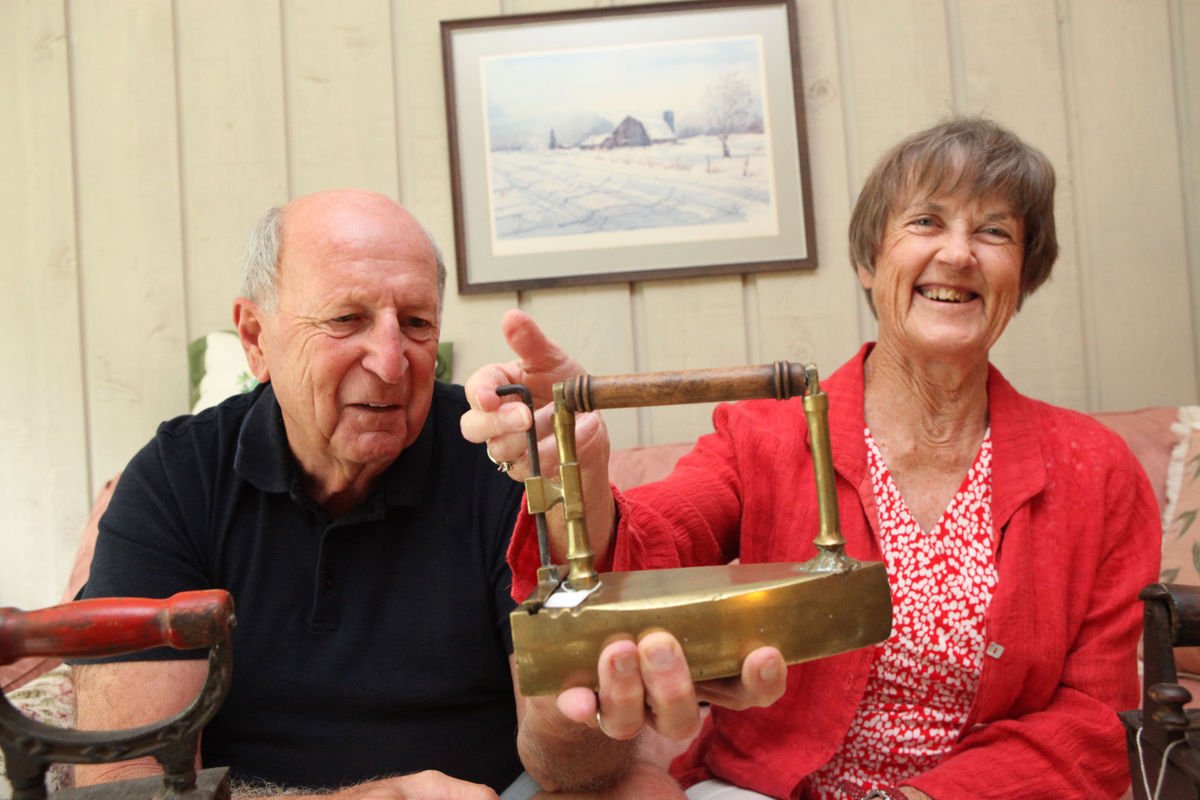
That old steamer trunk in the attic, the ring Grandma left you, the small table you bought at a flea market and are sure is a Federalist—are they worth more than you paid for them?
For some, that’s the vital question. For others, that’s not the point at all. We spoke to experts and admirers about their finds, and their stories are fun to hear. But every person explained the real value is in what the piece means to the purchaser.
Sharon Dzwonar of LaPorte has no intention of turning her finds into profit. Ever since she and husband Joe inherited a few antique sad irons from their grandmothers, Sharon is on the lookout for more to add to her collection of forty. “My wonderful irons—I don’t want to part with any of them.”
A few good bargains are there. A brass box iron she and husband Joe bought in 1971 for $20 was valued for insurance at $110 in 1996. Family history is important, too: Joe remembers his grandmother putting coals into a sad iron to make it hot. Some irons used charcoal that smoked, so keeping smoke away from the laundry required a certain finesse. Sharon has collected smaller, sample irons carried by tinkers from farm to farm; electric travel irons; and an iron fueled by kerosene in a 4-inch round tank. “I’m so glad I don’t have to use that!” she says. She has her grandmother’s box iron with two slugs that were heated on a stove, then inserted—carefully—into the space of the box iron and switched with the other one as the first cooled. They were all called sad irons, says Sharon, because they were so difficult to use. The couple also inherited flatware whose value remains high, and Sharon loves her collection of pretty biscuit tins.
ESTATE FINDS
Sometimes even an unpromising estate sale hides a good find. Brent Lemaich, co-owner with David Nadolski of Coachman Antique Mall in LaPorte, bought everything left over from a high-end estate sale gone-to-church sale. He broke open a locked, unremarkable end table to find it was filled with sterling silver, including Tiffany items, a sterling chalice worth about $2,000, and crystal epergnes.
Now retired from real estate, he’s been “doing antiques” for almost 40 years, and the stories are intriguing. An auctioneer told him at a yard sale, “You missed all the good stuff.”
“I picked up a little lamp and he said not to bother because it had a chip,” Lemaich says. “I paid fifty cents for it because it was cool.” Indeed. It was a Handel lamp, made in 1920, and Lemaich sold it for $800.
Lemaich, who now does an estate sale every week, had bought the entire house contents of a late retired schoolteacher. He found never-used Coach and Chanel purses and jewelry worth $2,000 to $3,000.
Working with an auctioneer at an estate sale at the old place of an elderly couple with no children, he discovered $10,000 hidden in a kitchen stove in the garage. At a LaPorte County place where the daughter didn’t want anything at all, Lemaich discovered one room packed to the ceiling with wedding gifts from 1953, all in their original boxes, as well as wedding pictures. ”That was sad,” he says. A truly breathless discovery years later: a letter signed by Mother Teresa.
David Nielsen, who with his wife Debbie has booths in antique stores in Northwest Indiana and Southwest Michigan, had acquired for about $200 an opalescent, 14-inch-tall Fenton art deco vase made in the 1930s. He knew the vase was rare, made by 1905-founded Fenton Art Glass Company, which in 2011 began to focus solely on glass jewelry to make use of remaining inventory. Neilsen had someone put it on eBay; after brisk bidding, the vase sold for $3,000. “We were jumping up and down!” he says.
Was that luck? Hardly. Nielsen has been an antique dealer since age 18, specializing in glass because he loves it. But experience alone may not guide you to the right pieces. Neilsen advises, “Invest in books on antiques. We believe every antique book has paid for itself.”
And it’s more than a matter of looking at a picture in a book. “There’s so much glass out there that you have to be knowledgeable to know what is a good piece—how it was made and by which company,” he says. “Even a color can alert you to the value of a piece.” The Neilsens discovered years ago that a lot of original Depression glass molds were bought by Asian managers who then made reproductions—some in colors never made in true Depression glass. Locally, “A reputable antique dealer isn’t likely to sell something that isn’t good; that will lose customers,” says Debbie.
Russ Stephens at Russ & Barb’s Antiques in Chesterton says he has hundreds of books on antiques. “If you haven’t seen it, how do you know what it is?” he asks. If you’re interested in a certain line of antiques like Depression glass, read about it first. Pick a pattern you like, but find out about it, because some companies made only a few pieces, Stephens explains. You may never get a whole place setting and serving pieces in that pattern.
He has a plate he bought at an antique show for $10. There were no markings on it, “But I knew what it was. I looked in one of the books,” and it’s worth at least $125.
Loretta Bryan Nosal, owner of Antiques on Main & Curiosities in Crown Point, says vinyl records are big collectors’ items, and her store has lots of them—but the variety and condition can make it a challenge to figure out what might be valuable. “Some of the vinyl albums you pick up for just a few dollars you might get for $0 or $50, depending,” she says. “Of course the Beatles are big, but other groups are, too. Collectors come in and run across that great find they’ve been seeking for years.”
TRUE VALUE
While the hunt and discovery of valuable antiques can be a thrill, Alan Robandt, who owns Robandt Antiques, Vintage & Modern in Buchanan, Michigan, has a different take on the hunt for profit for profit’s sake alone. An object’s value is intrinsic; it is the piece that makes you catch your breath because of its beauty or unusual features. Like all antique dealers, he delights in the great find—he’s in the business, after all—but Robandt’s passion is appreciation for the piece, and inviting others to share that appreciation.
“People will come in and tell their children not to touch, but I tell them, no, go ahead—if it breaks, we’ll fix it,” he says. Intimate knowledge of antiques teaches young people what to look for, what makes a piece not just desirable but of value for its own sake and for its place in history. It’s a knowledge Robandt thinks is missing for most millennials, who may even say they can’t afford antiques. “But their desire for the new and modern can be seen in where they put their money: stocks and bonds, dining out, houses, and expensive cars,” he says.
Robandt wonders if young people understand that antiques can enrich and be useful in modern-day life. An example is coin silver—pioneer miners’ finds of silver later melted down to create, for example, flatware. “It’s wonderful, lovely stuff,” Robandt says. “Clean, plain, not embellished in design, and works well with modern pieces. And it’s not understood that silver that’s used doesn’t have to be polished all the time.”
The Dzwonars know this. An antique wooden tool chest makes a perfect cocktail table in their sunroom. With two big handles and corners protected with metal caps, Sharon claims, “This was a work of pride.”
[Source: Inspired Living]



